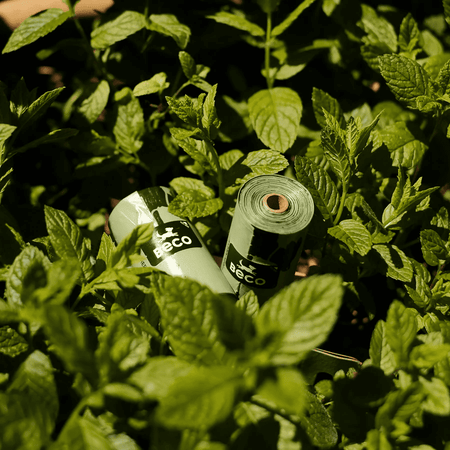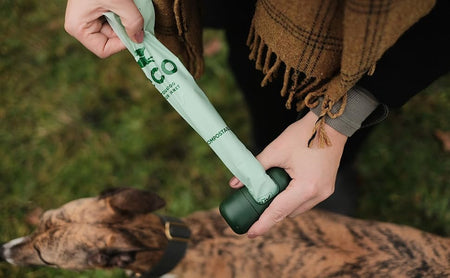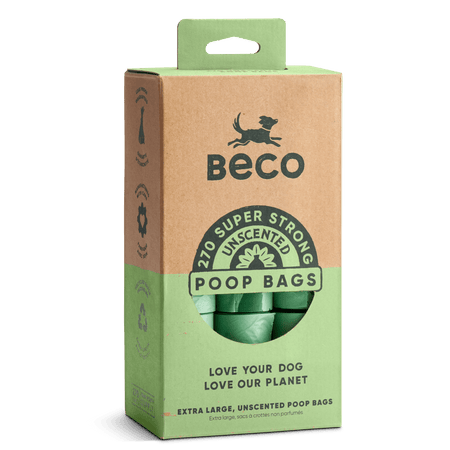Biodegradable dog poop bags are often seen as an easy eco win, but how long do they really take to break down?
The answer depends on where they end up, how they’re made, and whether conditions like oxygen and heat are present.
We’ll look at the actual decomposition timeline, what slows it down, and why recycled plastic bags may be a better low-impact choice for most people.
- Industrial composting breaks down bags in 90-180 days; home composting takes 6-12 months.
- Landfill disposal (where most bags end) can take years with risk of microplastic formation.
- Decomposition requires specific conditions: heat, oxygen, moisture, and microbial activity.
- Recycled plastic bags often more environmentally practical given current waste infrastructure.
What Does "Biodegradable" Really Mean?
Let’s start by clearing the air: just because a dog poop bag is labelled "biodegradable" doesn’t mean it’s going to disappear in a few weeks. I
n fact, the term "biodegradable" is often used loosely. And without proper context, it can be misleading.
In technical terms, biodegradable materials are designed to break down naturally with the help of microorganisms like bacteria and fungi. But here’s the catch: that process depends heavily on the surrounding conditions. Think oxygen, heat, moisture, and microbial activity.
And unfortunately, the places where most used poop bags end up (like landfills) don’t have those ideal conditions.
So, while the bag might break down eventually, it’s rarely quick or complete.
What Are Biodegradable Dog Poop Bags Made Of?
Biodegradable poop bags typically fall into a few categories, based on their material makeup:
-
Plant-based polymers like polylactic acid (PLA), derived from renewable resources such as cornstarch or sugarcane
-
PBAT (polybutylene adipate terephthalate), a fossil-fuel-based biodegradable plastic often blended with PLA
-
Traditional plastics with additives designed to speed up degradation
While some of these materials do break down under the right conditions, many still originate from fossil fuels. And even worse, some bags marketed as biodegradable simply fragment into smaller pieces – creating microplastics that linger in soil and water systems.
The bottom line: not all biodegradable bags are equal.
Some require composting systems to break down properly, while others just break apart without truly decomposing.
Biodegradable vs Compostable vs Oxo-Degradable: What’s the Difference?
These terms are often used interchangeably, but they shouldn't be.
Here’s how they differ:
Biodegradable
-
Breaks down via natural processes
-
May include traditional plastics with additives
-
Can leave behind microplastics
-
No time frame or standard guaranteed
Compostable
-
A subset of biodegradable with stricter standards
-
Certified to break down into safe, non-toxic compost
-
Requires industrial or high-heat home composting
-
Typically decomposes in 90–180 days (industrial)
Oxo-degradable
-
Made from regular plastics with metal salts or chemicals
-
Breaks down into fragments under UV/heat, not fully biodegradable
-
Often banned due to microplastic concerns
In short: compostable bags are the only category reliably designed to break down fully and safely, but only when disposed of correctly.
So, How Long Do Biodegradable Dog Poop Bags Take to Decompose?
The million-pound question. The answer? It depends.
Under industrial composting conditions where temperatures are kept above 58°C and oxygen levels are carefully managed, certified compostable bags can decompose fully within 90 to 180 days. Some brands achieve this in as little as 12 weeks.
In home composting systems, decomposition slows down considerably. Temperatures are lower and fluctuate with the weather, oxygen and moisture levels vary, and microbial activity isn’t always consistent.
In this environment, even the best compostable bags can take 6–12 months to fully break down.
In landfills, however, all bets are off. Anaerobic (low oxygen) conditions slow degradation to a crawl.
In many cases, biodegradable bags in landfill conditions can take years (if not decades) to break down, and they often fragment into microplastics instead of fully decomposing.
What Affects Decomposition Time?
The speed at which a bag breaks down depends on multiple factors, including:
-
Microbial activity – Microorganisms are essential to the process; more microbes = faster breakdown.
-
Moisture – A damp environment supports microbial life, but too much water can suffocate microbes.
-
Oxygen – Essential for aerobic decomposition (the cleanest, most efficient type).
-
Temperature – Warm environments (especially 50–60°C and up) dramatically increase degradation rates.
-
UV exposure – Sunlight can help break down plastic structures, although this is less helpful once a bag is buried or landfilled.
In short, a biodegradable bag sitting in the sunlit corner of a compost pile will break down much faster than one buried in a cold, airless landfill.
The Problem With Landfill Disposal
Unfortunately, the vast majority of dog poop bags, biodegradable or not, end up in landfill. And that’s a big problem.
Landfills are designed to minimise decomposition. They’re compacted, lined, and sealed to reduce contamination, which means they lack oxygen, moisture, and microbial activity – the exact ingredients needed for biodegradation.
As a result, biodegradable bags tend to sit there, mostly intact, for years.
Worse still, the anaerobic breakdown that does happen can generate methane, a greenhouse gas far more potent than carbon dioxide. And if a bag breaks down incompletely, it may leave behind microplastics that persist for generations.
So yes, the intent behind using biodegradable bags is good. But without proper infrastructure, the real-world outcome is less than ideal.
Why Recycled Plastic Is The Smarter Choice
Here’s where things get interesting.
While biodegradable sounds great in theory, in practice, recycled plastic bags often make more environmental sense – especially when you consider the current waste infrastructure.
-
They reuse existing plastic waste which reduces reliance on virgin plastic production.
-
They’re compatible with how most people dispose of waste – i.e., the regular bin.
-
They avoid the risk of microplastic formation from partially degraded bioplastics.
-
They don’t rely on infrastructure that doesn’t yet exist at scale.
At Beco, we’ve chosen to use post-consumer recycled plastic in our poop bags. Not because it sounds trendy, but because it works in real life. It’s strong, dependable, and helps keep existing plastic out of landfills and oceans.
When you consider how waste is managed, it’s a more responsible and realistic choice.
Frequently Asked Questions
Can I bury biodegradable dog poop bags in my garden?
Burying dog poop bags, even biodegradable ones, isn’t recommended. The soil may not reach high enough temperatures to break down pathogens in the waste or fully decompose the bag, potentially contaminating your garden.
Are flushable dog poop bags a safe alternative?
Generally, no. Even if labelled flushable, many bags can clog plumbing and aren’t processed well in sewage systems. It’s best to avoid flushing any bag unless explicitly approved by your local authority.
Do biodegradable bags have an expiry date?
Yes, many biodegradable bags have a shelf life of 12–24 months. Exposure to heat, humidity, or light can accelerate degradation, so they should be stored in a cool, dry place.
Are all compostable dog poop bags safe for worms in worm farms?
Not necessarily. Most worm farms don’t reach the temperatures needed to break down pet waste safely. Unless the bag and waste are certified for use in vermicomposting systems, it’s best to avoid this route.
Conclusion
Biodegradable dog poop bags sound like the greener choice, but the reality is more complicated. While some break down in a few months under ideal composting conditions, most end up in landfills where they can linger for years, sometimes creating microplastics or releasing methane.
In contrast, recycled plastic bags offer a practical, lower-impact option that works with the waste infrastructure we have. What matters most isn’t just the material, but where it goes and how it breaks down once it gets there.
If you’re after something strong, dependable, and made with the real world in mind, our recycled poop bags are a smart switch. Shop now!













